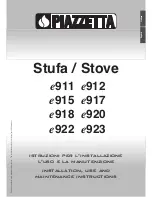
39
8.
Regulating the Combustion Air
We develop an individual air duct routing for each
Hase stove model, to ensure that the necessary
combustion air is guided to the right areas in the fire
box.
The primary air supplies the glowing embers with
oxygen. The secondary air is heated and guided to
the flame area. It minimises the formation of soot
on the fire box windows.
In addition, some stove models also use tertiary air,
which is usually drawn up the back of the fire box.
Depending on whether they are designed for burn
-
ing wood or for burning both wood and lignite
(brown coal), the stove models have either one or
two combustion air control elements. For informa-
tion on setting and regulating the combustion air
control elements, please see Part 1 of the operating
instructions.
WARNING!
Burning wood when the primary air slider
is opened too wide poses the risk of over-
heating the stove (forge fire effect).
The secondary air flow may not be com
-
pletely closed while the stove is in opera-
tion. If there is not a sufficient air supply,
there is a risk that the flue gases will not
burn completely (smouldering fire), that
soot will build up on the fire box window,
or that the amassed wood gases will burn
explosively (overfiring/deflagration).
NOTE!
When the stove is not in use, the airflow
slider(s) should remain completely closed
to avoid heat loss due to the unintentional
throughflow of cold air.
9.
The Right Fuel
Only fuels which generate low quantities of smoke
may be burned in stoves. For your stove, natural,
untreated logs, including the adhering bark:
You can also fuel with wood briquettes as specifi ed
in DIN 51731 Hb2 or of equal quality. Please note
that wood briquettes swell and expand during com
-
bustion. As compared to the amount of fuel when
using logs, reduce the amount by ap-prox. 10-20%
based on the calorifi c value of the wood briquettes.
The control element settings and procedure are the
same as when burning logs:
Depending on the stove model, charcoal briquettes
can be used as well (see Operating Instructions
Part I).
For the most attractive stove fire, use beech wood
logs. If other types of wood are used, such as oak,
birch, pine or larch, we recommend adding beech
wood for picturesque dancing flames. Brushwood
and small pieces of wood are good kindling materi-
als.
Highly resinous coniferous wood (e.g. spruce, pine,
fir) tends to emit flying sparks and leaves behind a
fine layer of flue ash that can swirl up when the fire
box door is opened.
The firewood should be stored for at least two years
to achieve the required maximum residual moisture
content of 20 %.
CAUTION!
If the wood used as fuel is too moist, wa-
ter vapour can condense and damage the
stove. In addition, it will reduce the ther-
mal output.
CAUTION!
Burning, e.g.:
- damp or moist wood (residual moisture
content over 20 %),
- varnished, laminated, treated, or
plastic-coated wood,
- wood treated with wood preservatives,
- household waste,
- paper briquettes (contains pollutants
such as cadmium, lead, zinc), or
- any flammable fluids (including metha
-
nol and ethanol) as well as any fuel
pastes or gels is not permitted.
ENVIRONMENT!
Combustion of the materials listed above
not only gives off unpleasant odours, but
also generates emissions that damage the
environment and are harmful to health.
Combustion of non-permitted fuels con-
stitutes a violation of the German Federal
Immission Control Act.
Improper fuels and their combustion resi-
dues can be detrimental to the functioning
and service life of the stove and chimney.
Summary of Contents for Sendai 175
Page 2: ......
Page 3: ...R16_08 16 Deutsch S 4 13 Français P 14 23 Italiano P 24 33 English P 34 43 Nederlands P 44 53 ...
Page 54: ......
Page 55: ......
Page 56: ...hase de ...
















































